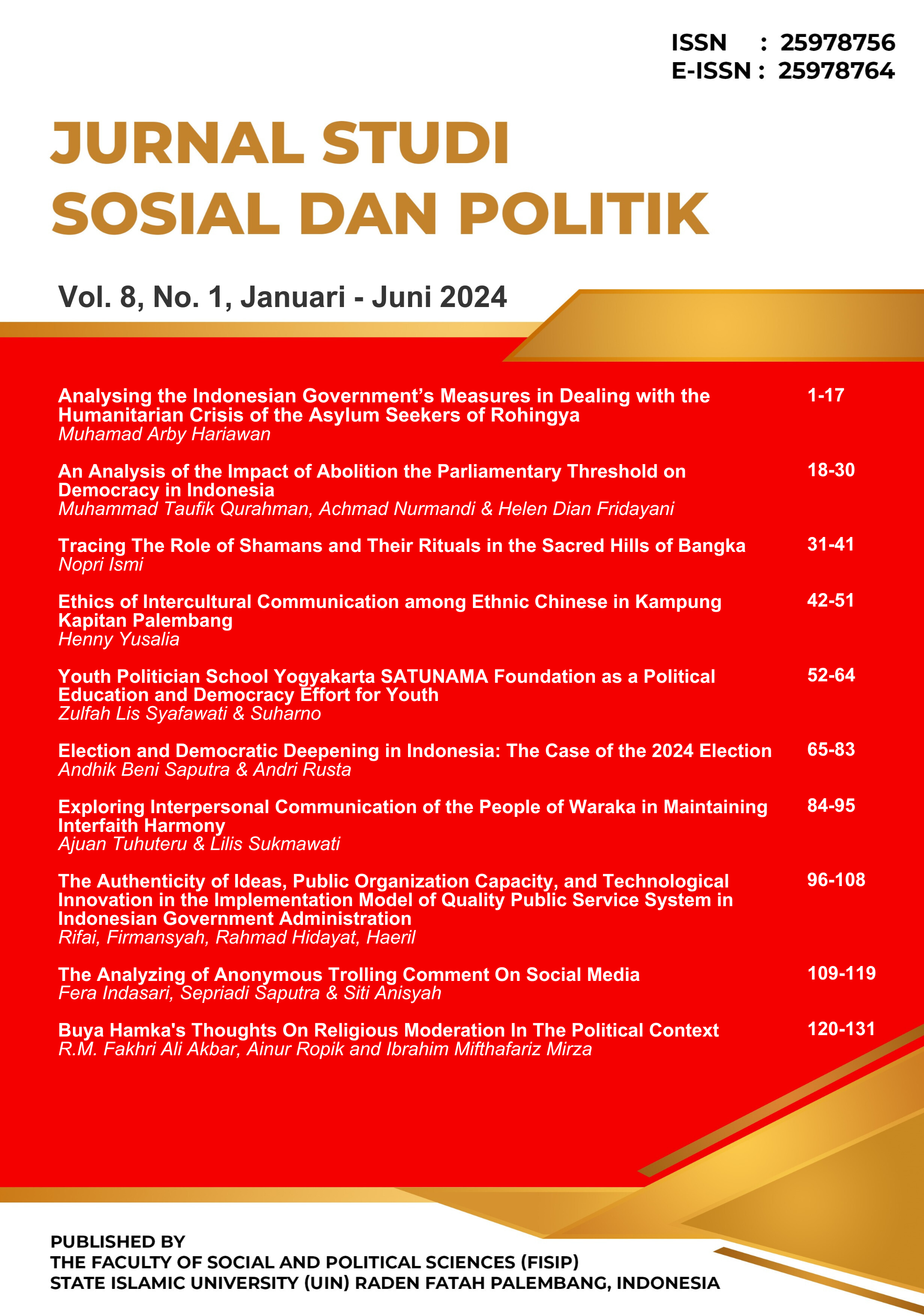Exploring Interpersonal Communication of the People of Waraka in Maintaining Interfaith Harmony
Main Article Content
Abstract
Keywords: Harmony, Interpersonal Communication, Interfaith Communication, Waraka Country
Article Details

This work is licensed under a Creative Commons Attribution-ShareAlike 4.0 International License.
Authors who publish with this journal agree to the following terms:
- Authors retain copyright and grant the journal right of first publication with the work simultaneously licensed under a Creative Commons Attribution License that allows others to share the work with an acknowledgement of the work's authorship and initial publication in this journal.
- Authors are able to enter into separate, additional contractual arrangements for the non-exclusive distribution of the journal's published version of the work (e.g., post it to an institutional repository or publish it in a book), with an acknowledgement of its initial publication in this journal.
- Authors are permitted and encouraged to post their work online (e.g., in institutional repositories or on their website) prior to and during the submission process, as it can lead to productive exchanges, as well as earlier and greater citation of published work.
How to Cite
References
Ambarita, J., & Ririhena, I. (2022). Mengelola Keragaman Agama di Lembaga Pendidikan Tinggi Institut Agama Kristen Negeri Ambon. Dialog, 45(1), 81–98. https://doi.org/10.47655/dialog.v45i1.529
Ananda, R. (2017). Implementasi Nilai-nilai Moral dan Agama pada Anak Usia Dini. Jurnal Obsesi : Jurnal Pendidikan Anak Usia Dini, 1(1), 19. https://doi.org/10.31004/obsesi.v1i1.28
Aras, M. (n.d.). Melalui penelitian studi kasus, model komunikasi sosial terbukti dapat meningkatkan toleransi dan harmoni lintas agama dalam masyarakat Indon. https://www.binus.edu/fostering-and-empowering/post/model-komunikasi-sosial-lintas-agama-kontribusi-dr-muhamad-aras-s-pd-m-si-dan-dr-ir-alexander-agung-santoso-gunawan-m-si-m-sc-ipm-untuk-memperkuat-toleransi-dan-harmoni-masyarakat-indon-2
Hakis, H. (2015). Komunikasi Antar Umat Beragama di Kota Ambon. Jurnal Komunikasi Islam, 5(1), 98–113. http://jki.uinsby.ac.id/index.php/jki/article/view/73
Hariandi, A., Sari, C. O. Y., Zahara, D., Hapsari, H. P., & Mubarokah, L. B. (2023). Nilai-Nilai Moral Terkandung dalam Tradisi Arakan Sahur di Kabupaten Tanjung Jabung Barat. Jurnal Ilmiah Religiosity Entity Humanity (JIREH), 5(1), 83–96. https://doi.org/10.37364/jireh.v5i1.133
Hermawati, R., Paskarina, C., & Runiawati, N. (2016). Toleransi Antar Umat Beragama di Kota Bandung. Umbara: Indonesian Journal of Anthropology, 1(2), 105–124. https://doi.org/https://doi.org/10.24198/umbara.v1i2.10341
Hernawan, W. (2010). Komunikasi Antar Umat Berbeda Agama (Studi Kasus Sikap Sosial dalam Keragaman Beragama di Kecamatan Cigugur Kabupaten Kuningan Jawa Barat). Jurnal Kom Dan Realitas Sosial, 1(1), 1–13.
Jenri Ambarita, D. (n.d.). KERAGAMAN DAN KERUKUNAN DI NEGERI WARAKA.
Krech, D., Crutehfield, R. S., & Ballachey, E. L. (1962). Individual in Society: A Texbook of Social Psychology. McGraw Hill.
Liliweri, A. (2017). Komunikasi Antar-Personal (Cetakan ke). Kencana.
Littlejohn, S. W. dan K. A. F. (n.d.). TEORI KOMUNIKASI-Theories of Human Communication. Salemba Humanika.
Miftah, M., & Muiz, M. N. Al. (2020). Quantum Learning Dan Fitrah Manusia Dalam Perspektif Pendidikan Islam. INSANIA : Jurnal Pemikiran Alternatif Kependidikan, 25(1), 14–22. https://doi.org/10.24090/insania.v25i1.2820
Miles, M. B., & Huberman, A. M. (1992). Analisis Data Kualitatif: Buku Sumber tentang Metode-metode Baru-Terjemahan. Universitas Indonesia.
Nurdin Ali, D. (2022). IMPRESSION MANAGEMENT KOMUNIKASI LINTAS Ali Nurdin Ali Abdul Wakhid Abstract : Abstrak : A . Pendahuluan Indonesia memiliki keragaman dalam etnik , suku , ras , dan agama . Masyarakat Indonesia adalah masyarakat majmuk dan plural 1 . 17(1), 69–102.
RI, B.P.B.P.K.P.danK. (2016). Kamus Besar Bahasa Indonesia-Edisi Kelima. https://github.comyukuku/kbbi4
Ricard Y. B. Lailossa, dan I. N. (2023). SEAJARAH MASUKNYA ISLAM DI NEGERI WARAKA.
Riyanto, B., Muadz, & Ali, F. (2022). Pola Komunikasi Lintas Agama Mahasiswa Universitas Slamet Riyadi Surakarta. Sahafa: Jurnal Of Islamic Comunication, 4(2), 46–56.
Rozak, A. (2008). Komunikasi Lintas Agama : Modal Sosial Pembentukan Masyarakat Sipil. Dakawah, IX(l), 13–28.
Sukmawati, L. (2019). Tradisi Tabaus sebagai Saluran Komunikasi Tradisional dalam Penyebaran Informasi di Masyarakat Negeri Buano Utara. Universitas Hasanuddin Makassar.
Sunarso, B. (2021). Perilaku Organisasi (1st ed.). Uwais Inspirasi Indonesia.
Undang-Undang RI Nomor 39. (1999). UNDANG-UNDANG REPUBLIK INDONESIA NOMOR 39 TAHUN 1999 TENTANG HAK ASASI MANUSIA. 1(10), 9–39.
Waraka, N. (2016). Rencana Pembangunan Jangka Menengah (RPJM) Negeri Waraka.
Wibisono, M. Y. (2017). Agama, Kekerasan Dan Pluralisme Dalam Islam. Kalam, 9(2), 187. https://doi.org/10.24042/klm.v9i2.328

